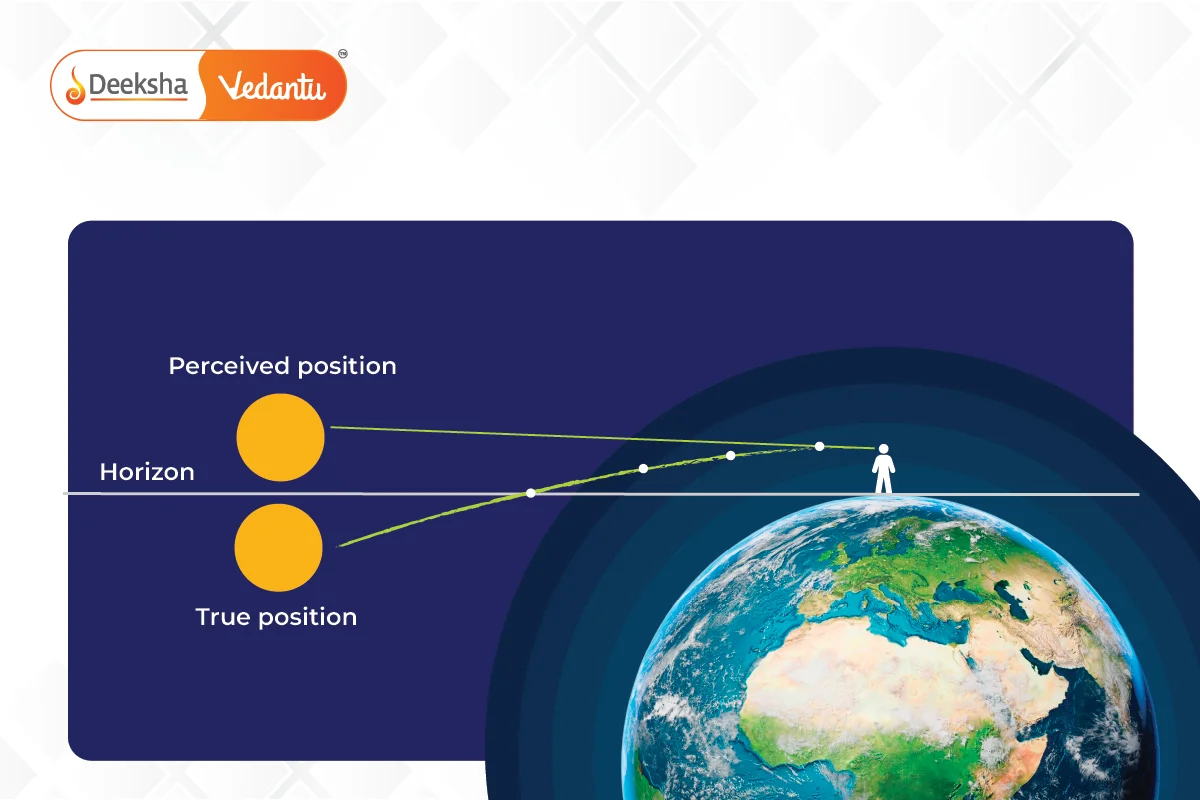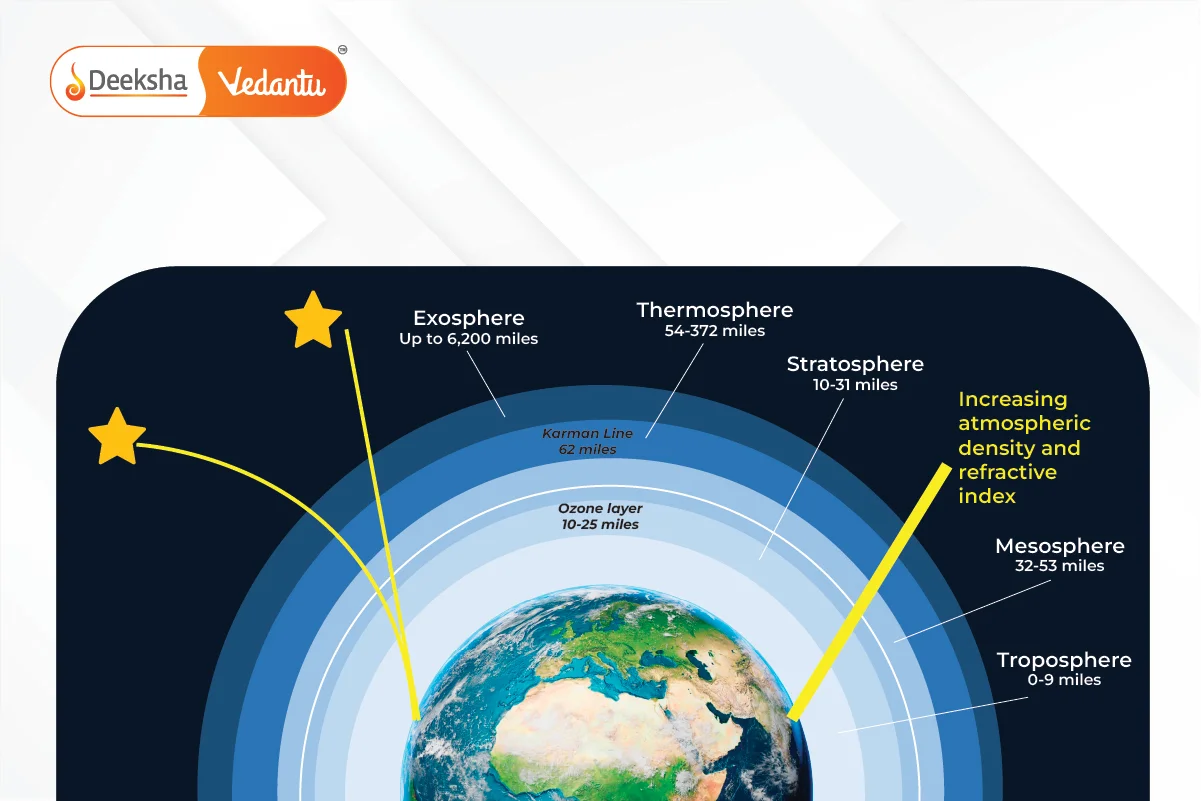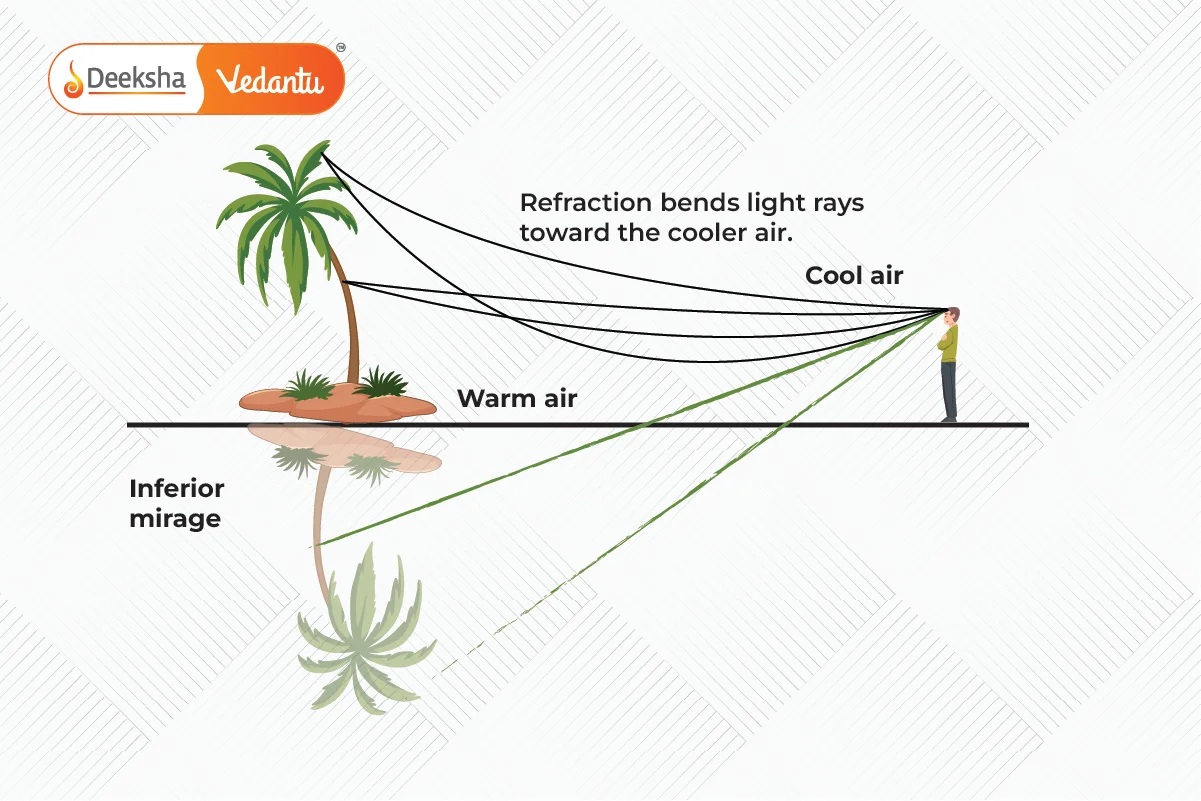Introduction to Atmospheric Refraction
Atmospheric refraction refers to the bending of light as it travels through the Earth’s atmosphere, which consists of layers of air with varying temperatures, pressures, and densities. Because the refractive index of air is not constant and changes with altitude, light rays experience continuous refraction as they move through the atmosphere. This bending of light is responsible for many natural optical phenomena, such as the twinkling of stars, the apparent shift in the position of celestial objects, advanced sunrise, delayed sunset, and the formation of mirages.
In this section, we will explore how light behaves in the atmosphere, the scientific principles behind atmospheric refraction, and its observable effects in nature.
What is Atmospheric Refraction?
Atmospheric refraction is the phenomenon where light bends as it passes through the Earth’s atmosphere, which acts as a medium with continuously varying density. The atmosphere consists of several layers of air, each with a different refractive index due to changes in temperature, pressure, and humidity.
Key Points of Atmospheric Refraction:
- Refractive Index of Air: The refractive index of air increases with air density. Since the density of the atmosphere decreases with altitude, the refractive index also decreases with height. As light passes through these layers of varying densities, it refracts continuously.
- Bending of Light: Light bends toward the normal when it passes from a less dense (rarer) to a denser medium. In the atmosphere, this means that light rays bend as they move from the upper layers of the atmosphere (less dense) to the lower layers (denser).
- Curved Path of Light: Due to the continuous refraction through layers of varying refractive indices, light travels in a slightly curved path rather than a straight line.
Scientific Explanation:
The bending of light in the atmosphere can be explained by Snell’s Law, which governs the refraction of light as it passes from one medium to another. According to Snell’s Law:
Where:
= Angle of incidence
= Angle of refraction
= Refractive index of the first medium (air)
= Refractive index of the second medium (atmospheric layer)
In the atmosphere, since the refractive index is not constant, the angle of refraction changes continuously, resulting in the bending of light.

Effects of Atmospheric Refraction
Atmospheric refraction gives rise to several optical phenomena that are observable in the natural world. Some of the most well-known effects include:
Twinkling of Stars
One of the most noticeable effects of atmospheric refraction is the twinkling of stars. Stars appear to twinkle because their light undergoes multiple refractions as it passes through the Earth’s turbulent atmosphere. Variations in air temperature, pressure, and density cause the light from a star to bend in slightly different directions as it reaches the observer, making the star’s brightness fluctuate.
Explanation:
- Point Source of Light: Stars are so far away from the Earth that they appear as point sources of light. Because of this, even small changes in the refractive index of the atmosphere cause noticeable fluctuations in the light that reaches the observer.
- Atmospheric Turbulence: The atmosphere is not a static medium; it is constantly in motion, with different layers of air mixing and changing in density. This turbulence affects the path of light from the star, making it appear to twinkle.
- Variation in Brightness: As the starlight refracts through the atmosphere, its intensity changes, making the star seem brighter at some moments and dimmer at others. This fluctuation in brightness is what we observe as twinkling.
Why Planets Do Not Twinkle:
Planets do not twinkle as much as stars because they are much closer to Earth and appear as extended sources of light. Since the light from different parts of the planet reaches the observer simultaneously, the fluctuations in brightness caused by atmospheric turbulence are canceled out, making the planet appear steady.

Key Concept:
- Stars twinkle because their light passes through the Earth’s turbulent atmosphere and undergoes continuous refraction, which causes variations in the light’s intensity.
- Planets, being closer and extended sources of light, do not twinkle because the fluctuations in brightness from different parts of the planet cancel out.
Apparent Position of Stars
Atmospheric refraction causes stars to appear in a different position in the sky than their actual position. As the starlight enters the Earth’s atmosphere, it bends due to the changing refractive index of the air. This bending makes the star appear higher in the sky than it actually is.
Explanation:
- Bending of Starlight: As starlight passes through the atmosphere, it bends towards the Earth. The bending is more pronounced for stars near the horizon because the light has to travel through more atmosphere. The greater the distance the light travels through the atmosphere, the more it bends.
- Shift in Apparent Position: This bending causes a shift in the apparent position of the star. The star appears slightly higher in the sky than its true position. The closer the star is to the horizon, the larger the apparent shift.
Key Concept:
- The apparent position of a star is different from its actual position due to the continuous bending of light as it travels through the atmosphere. This bending is more significant when the star is near the horizon.
Advanced Sunrise and Delayed Sunset
Atmospheric refraction causes the Sun to appear above the horizon earlier than its actual rise and to remain visible for a few minutes after it has physically set. This phenomenon is known as advanced sunrise and delayed sunset.
Explanation:
- Bending of Sunlight: As sunlight enters the Earth’s atmosphere, it bends due to refraction. When the Sun is just below the horizon, its light bends and reaches the observer before the Sun itself has risen. Similarly, after the Sun has set below the horizon, its light continues to bend toward the observer, making it appear as though the Sun is still above the horizon.
- Effect of Atmospheric Refraction on Daylight: Atmospheric refraction adds about 4 minutes to the length of the day—2 minutes for advanced sunrise and 2 minutes for delayed sunset.
Key Points:
- Advanced Sunrise: Due to atmospheric refraction, the Sun appears to rise 2 minutes earlier than its actual position.
- Delayed Sunset: The Sun remains visible for about 2 minutes longer after it has set below the horizon.

Key Concept:
- Atmospheric refraction causes the Sun to appear higher than its actual position, allowing us to see the Sun before it rises and after it sets.
Flattening of the Sun at Sunrise and Sunset
Another effect of atmospheric refraction is the apparent flattening of the Sun during sunrise and sunset. The lower part of the Sun appears to be stretched out more than the upper part, creating a flattened or elliptical shape.
Explanation:
- Uneven Refraction: When the Sun is near the horizon, the light from the lower part of the Sun passes through more atmosphere than the light from the upper part. As a result, the lower part of the Sun is refracted more, making it appear “stretched” or flattened.
- Effect on Shape: This uneven bending of light causes the Sun to appear elliptical or flattened near the horizon.
Key Concept:
- The Sun appears flattened at the horizon due to the uneven refraction of light from its upper and lower parts. The lower part of the Sun experiences more refraction because it passes through more atmosphere.
Mirage Formation
A mirage is an optical illusion caused by atmospheric refraction. Mirages often occur in deserts or on hot roads, where the ground heats the air close to the surface, creating a temperature gradient. The difference in temperature causes the light to bend, creating the illusion of water or distant objects.
Explanation:
- Temperature Gradient: On hot days, the air near the ground becomes much hotter and less dense than the cooler air above it. This creates a temperature gradient, where the refractive index of the air changes rapidly with height.
- Bending of Light Rays: When light rays from the sky pass through this gradient, they bend upward as they travel from cooler to hotter air (denser to rarer medium). The bending of light causes the observer to perceive a reflection of the sky on the ground, which looks like a pool of water.
Inferior Mirage: The most common type of mirage is the inferior mirage, where distant objects (such as the sky) appear to be reflected on the ground. This is often seen on hot roads, where the illusion of water is created.

Key Concept:
- Mirages are caused by the refraction of light through layers of air with varying temperatures. This bending of light creates the illusion of water or distant objects on the ground.
Real-Life Examples of Atmospheric Refraction
The Twinkling of Stars vs. Planets
Stars twinkle because they are far away and appear as point sources of light. The light from a star is easily affected by atmospheric refraction, making the star appear to twinkle. Planets, being much closer to the Earth and appearing as extended sources of light, do not twinkle because the fluctuations in brightness from different parts of the planet cancel out.
Rainbow Formation
While not directly caused by atmospheric refraction, rainbows are formed due to a combination of refraction, dispersion, and internal reflection in water droplets. When sunlight passes through raindrops, it refracts, disperses into its constituent colors, and reflects internally before exiting, forming a spectrum of colors. The rainbow appears as a circular arc with red on the outside and violet on the inside.
Looming
Looming is an optical phenomenon where distant objects, such as ships or mountains, appear to float above the horizon due to atmospheric refraction. This effect occurs because light rays bend downward as they pass through layers of air with varying densities, making distant objects appear higher than they actually are.
Practice Questions with Answers
Q1: What is atmospheric refraction?
- Answer: Atmospheric refraction is the bending of light as it passes through the Earth’s atmosphere, which has varying densities and refractive indices. This bending causes optical phenomena such as the twinkling of stars, advanced sunrise, delayed sunset, and mirages.
Q2: Why do stars twinkle, but planets do not?
- Answer: Stars twinkle because they are point sources of light, and their light is affected by the Earth’s turbulent atmosphere, causing fluctuations in brightness. Planets, being closer and appearing as extended sources of light, do not twinkle as much because the fluctuations in brightness from different parts of the planet cancel out.
Q3: How does atmospheric refraction cause the Sun to appear higher than its actual position?
- Answer: Atmospheric refraction bends the light from the Sun as it passes through the Earth’s atmosphere. This bending causes the Sun to appear higher in the sky than its actual position. This effect is most noticeable during sunrise and sunset.
Q4: What causes a mirage, and how is it related to atmospheric refraction?
- Answer: A mirage is caused by the refraction of light through layers of air with different temperatures. On hot days, the air near the ground is much hotter and less dense than the air above it. Light rays bend as they pass through these layers, creating the illusion of water or distant objects on the ground.
Q5: Why does the Sun appear flattened during sunrise and sunset?
- Answer: The Sun appears flattened during sunrise and sunset because the light from the lower part of the Sun passes through more atmosphere than the light from the upper part. This uneven refraction causes the lower part of the Sun to be refracted more, making the Sun appear elliptical or flattened.
FAQs
Astronomers must account for atmospheric refraction when observing celestial bodies. The bending of light by the atmosphere causes objects to appear in slightly different positions than their true locations. This effect is especially significant for objects near the horizon.
A superior mirage occurs when the air near the surface is cooler than the air above it (the opposite of an inferior mirage). In this case, light rays bend downward, making distant objects appear elevated or floating in the sky. This phenomenon is commonly seen in polar regions.
Atmospheric refraction adds about 4 minutes to the length of the day—2 minutes for advanced sunrise and 2 minutes for delayed sunset. This extends the amount of visible daylight by bending the light from the Sun before it rises and after it sets.
Yes, atmospheric refraction affects the apparent position of all celestial objects, including the Moon. The Moon appears slightly higher in the sky than its actual position due to the bending of its light as it passes through the atmosphere.
Stars near the horizon twinkle more because their light passes through a larger portion of the Earth’s atmosphere, encountering more turbulence and refraction. This causes greater fluctuations in the brightness of the star.
Related Topics
- Difference between AC and DC
- P-N Junction
- Velocity
- Fleming’s Left-Hand Rule and Right-Hand Rule
- Concave Mirrors and Convex Mirrors
- Heating Effect Of Electric Current
- The Human Eye And The Colourful World
- Defects Of Vision And Their Correction
- Reflection Of Light
- Spherical Mirrors
- Energy
- Kirchhoff’s Law
- Wheatstone Bridge
- Refraction Of Light Through A Prism
- Electric Current And Circuit



![Rendered by QuickLaTeX.com \[\boldsymbol{\frac{\sin i}{\sin r} = \frac{n_2}{n_1}}\]](https://deekshalearning.com/wp-content/ql-cache/quicklatex.com-61e4c9231e5443eab5def2320321449a_l3.png)





Get Social